I heard photographer Stephen Shore at Arcadia last Tuesday night. The current exhibit at the college, Mystic River, is an homage to all things Shorian and especially to the photographer’s 1979 photo Merced River. (see prior post announcing the event.)
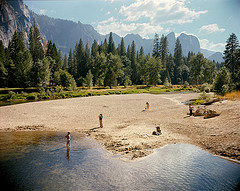
Stephen Shore, Merced River, 1979, the photo that spawned the idea for Mystic River the exhibit at Arcadia.
The pioneer of color photography whose work appeared last January at PS 1 in the show American Surfaces showed slides of new works — books he’s producing through digital technology and on-demand publishing. This to me was the news of the evening. Here is an artist who is an influential master of the photo genre whose early works are considered seminal influences on some of today’s photo superstars like Thomas Struth and Andreas Gursky (the early works). And he’s found a way to harness his talent to new tools and create a different kind of product (for him), artist’s books in editions of 20, some of which (based on what he showed) are pretty great.
After showing the slides, Shore spoke with Mystic River’s curator Noah Sheldon and with artist and writer Roger White, both of whom have works in the show (up to Oct. 22).
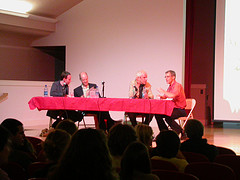
The panel at Arcadia before it began. Left to right are Roger White, Noah Sheldon, Stephen Shore and Richard Torchia.
Unfortunately for all of us the sound system was not working well and while I did my best to take notes I may have missed things. The show, by the way, has one of Shore’s new artist’s books, Merced River, 2003,on a little shelf where you can hold it and flip the pages. The book is a dissection of the photo and I enjoyed the Rashomon-like split perspective on the whole.
Noah Sheldon’s video in the show does something similar — cuts apart the photo by panning slowly and lovingly across the surface creating a sublime motion picture from the 70’s American sublime still image. The video is an odd cinema verite and the moody soundtrack by several composers enhances the feel that something’s about to happen but you can’t imagine what.
Here’s my notes of the talk.
SHORE:
For the past three years I’ve been shooting with the aim of making small artists books. One of them, Merced River, is in this show. Series 1 is high res scans of past work which I am re-editing (like Mt. Shasta and Merced River); Series 2 is new work with a digital camera.
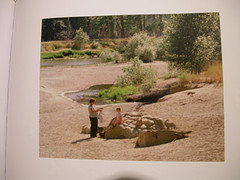
Page from the new (2003) book, Merced River, in which the artist cuts apart the original photo and serves it up piece by piece.
I use print-on-demand technology. They’re 4-color printed books. The books have 10-20 pictures (not many) because I want the viewer to hold the whole book in their mind all at once.
These books have tremendous potential as artists’ books.
My books done with digital photographs, all the pictures are done in one day. I am thinking the project through while shooting. Thinking how the photos will relate.
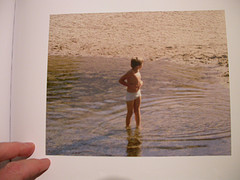
Another page from Merced River (2003) book
[Synopsis of book ideas: One book is a walk across 23rd St. in New York; one is shots all taken looking one way at an intersection in Los Angeles. There’s one called White Garden where Shore spray painted a flower or leaf and showcases it against a thicket of greenery. There’s a Times Square book at an intersection with all the shots looking in the same direction.]
What I’m interested in is the different weight of one photo on a wall versus in a book. Some of the new photos for the books I wouldn’t show on a wall but they work just fine in the book.
NOAH SHELDON: They seem playful and conceptual.
SHORE; Yes. Some are cultural observations. I don’t always have an idea when I shoot with the digital camera. Then when I shoot it develops. For example I was in Vienna at a flea market and it developed that way.
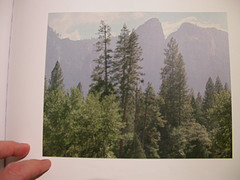
Dissecting the image into component parts gives it a kind of split point of view that you don’t get in the single image. Very Rashomon.
In the past three years I’ve made around 55 books in editions of 20 copies.
SHELDON (talking about his video based on Merced river). We talked about Ken Burns’s PBS documentaries. I thought if you gave Merced River to Ken Burns he could make a movie of it. So I learned “After Effects” (animation program) and took the file Stephen game me and tried to make a movie out of it. I experimented a long time. The DVD plays five times with five sound tracks. I asked 5 composers to write the music. I’m interested in emotional states. The music plays throughout the show and affects how you see the other works.
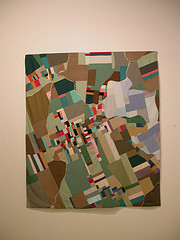
Ian Hundley’s quilt piece, South River, 2006. quilted fabric, 68″x58.” Part of the Mystic River exhibit.
ROGER WHITE: Some of the works in the show go far afield from Merced River and it’s hard to see at first how it relates to the picture. But they relate by mood, or material culture.
…Was your art influenced by other art?
SHORE: Three or four people influenced me: Walker Evans, Warhol, Ed Ruscha… I grew up with it at the Met. I spent hours and hours looking at the ways Pisarro structures his foreground; at the balance of form and color in Turner; at what structure means to a work.
SHELDON: What about film?
SHORE: You know, I think less so. I’ve looked at lots but haven’t really throught it’s an influence.
SHELDON: Your color..
SHORE: My color is post card color. I collected postcards for a long time. A lot of photos are to make a nice picture. Some have a simple motive–to show something. 80% of postcards are made to show something. Here’s how this looks or that. There must be hundreds of photos on the web. I saw pictures of the London Underground bombings — cellphone pictures….they had complete energy and were different than the AP photographs.
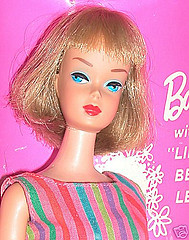
I call her eBay Barbie. This is a photo I assume Shore likes. I found it on the online auction site.
I went on Flickr and I saw thousands of pieces of shit. What they had in common was they all tried to be art. Then a couple weeks ago a friend told me about a fabulous online treasure, EBAY. The photos to sell things like water bottles. And those pictures are fabulous!
That’s what I liked about postcards. They’re simple and show something.
The first color work I did was color postcards. In Amarillo, with Dexter Press. They look like postcards. Five of the subjects were typical postcard images–Main St., county courthouse, hospital (for some reason there are lots of hospital postcards). Five of the subjects were quirky things you’d never see in postcards–Dong’s Barbeque, Double Dip army navy store.
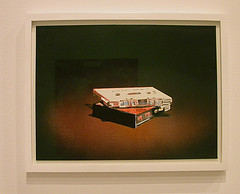
Dike Blair, untitled audio casette 1988, gouache and enamel spray on paper. this piece is in the Mystic River exhibit. See more images from the show and more pages from Stephen Shore’s book Merced river at flickr.
I convinced myself what New York needed was postcards of Amarillo. I made 56,000 cards and printed them and didn’t sell any. The cards were meant to be generic. They don’t give the name of the city. So I’d go to postcard racks in cities where I was and would stuff ’em in there. Sometimes I’d go back and check and there’d be none left. They probably sold them.
WHITE: Your new books seem to be trying to get at artlessness
SHORE: I don’t have a way ot taking pictures anymore. Or, this is how I take pictures. In the 70s I had a look. I was solving problems. I have different ideas now and don’t need to limit myself to a particular look.
A writer asked me once about my signature style and it was like nails scratching me.
WHITE: …Film-like?
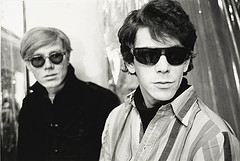
Stephen Shore, Andy Warhol and Lou Reed. 1966. Shore (b. 1947) was a child prodigy with a camera. Among other things, he had a photo purchased by the Met when he was 14, and he was a documentarian of the Warhol Factory and Velvet Underground. By the way, I found this photo on eBay–asking price, $4,600.
SHORE: American Surfaces (show at PS 1 in Jan. 2006 that was a visual diary of his travels in 1972-73). [There is also a book, American Surfaces, published by Phaidon with some 300 color illustrations.] It was a visual diary of my life. Every meal I ate, every person I met. I made obsessive lists of what I ate and where I went.
In most of the 70s I shot 8″ x 10″ color. Right now a picture like that costs $30 (to develop and print). In the 70s it was probably $15. That camera is an old fashioned camera on a tripod. I’d go under a dark cloth to focus. It’s a 19th Century camera but it produces resolution and tonality that nothing else is comparable. [Uncommon Places is the book that resulted from his 70s era road trip with the big camera and tripod.]
So I only took one picture and wouldn’t crop. I’d make decisions and live by them. I was very aware of the decision-making.
For me part of the joy of photography is to set up the camera and wait for something to happen. There’s a feeling that this is just great–that’s the fun of it.









